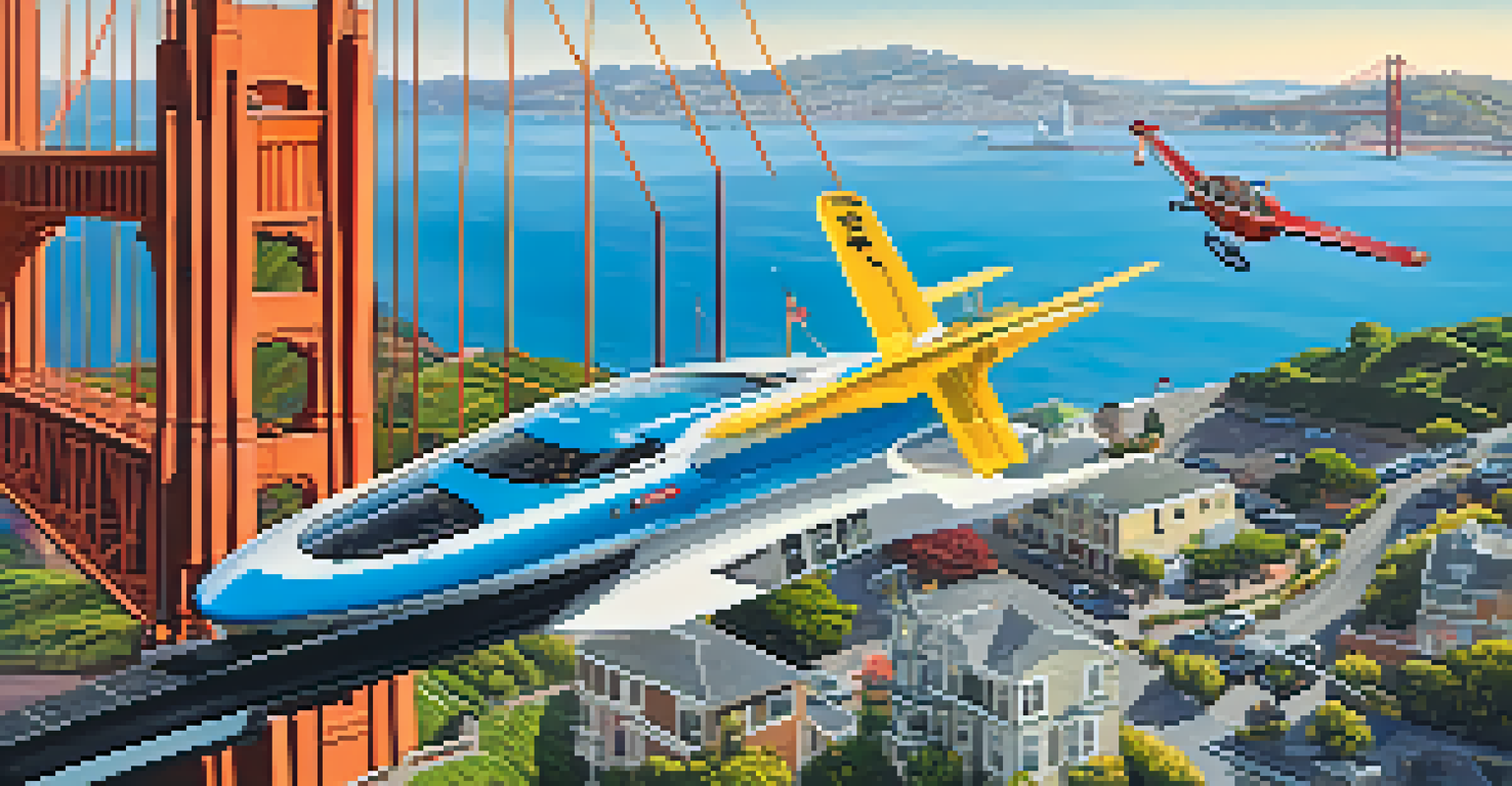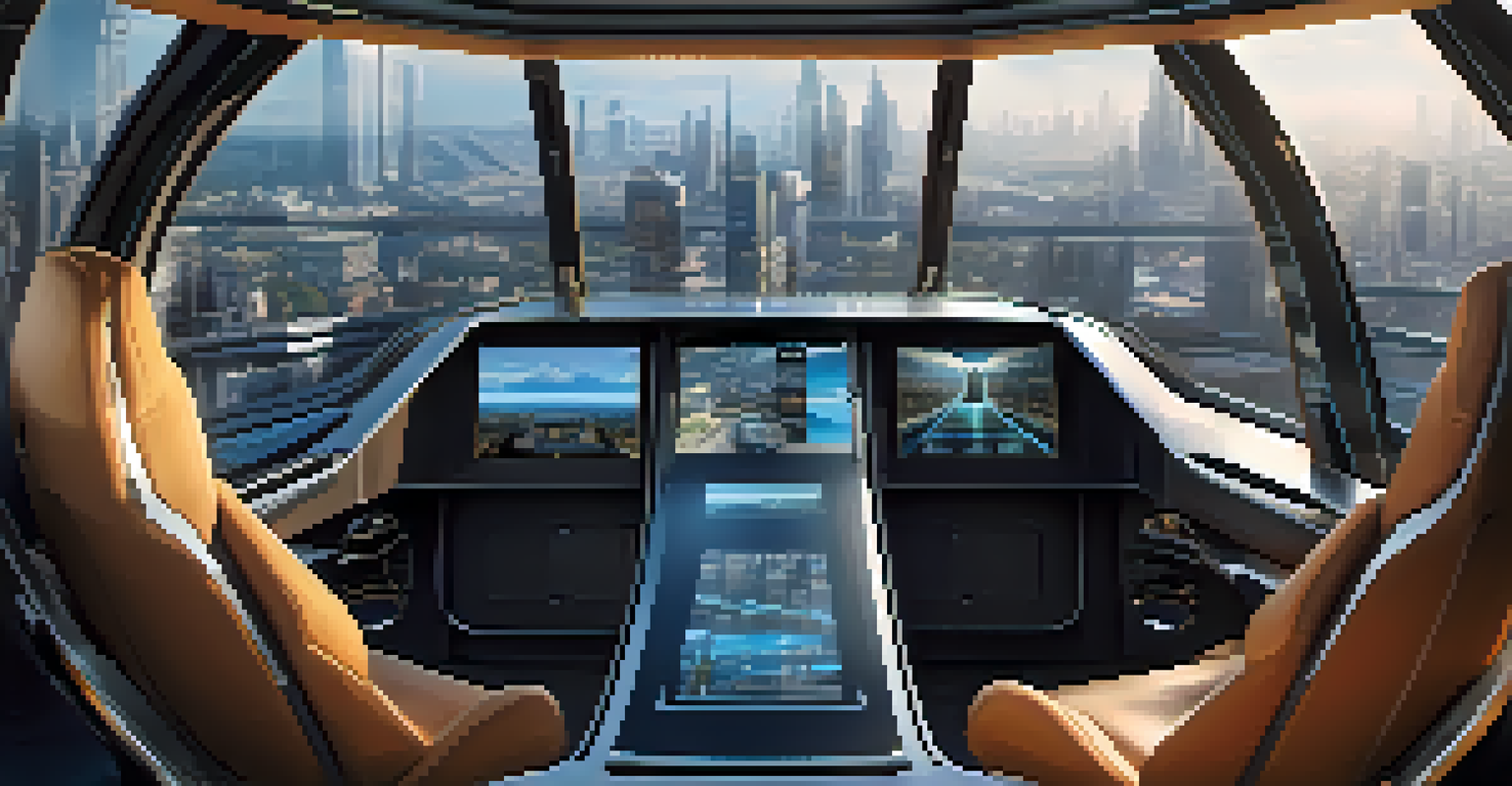Flying Taxis: The Next Frontier in San Francisco Transportation

What Are Flying Taxis and How Do They Work?
Flying taxis, also known as eVTOLs (electric Vertical Take-Off and Landing aircraft), are innovative vehicles designed to transport passengers through the air. Imagine a drone that can carry people instead of packages, lifting off from rooftops and zipping through the skies. These electric-powered aircraft are engineered to be quiet, efficient, and eco-friendly, making them an appealing option for urban environments like San Francisco.
The future of transportation is not just about moving people from point A to point B, it's about creating a seamless experience that integrates various modes of transport.
The concept of flying taxis is not just science fiction; companies like Joby Aviation and Archer Aviation are already developing prototypes that are undergoing testing. These aircraft are equipped with advanced navigation systems and can take off and land vertically, enabling them to operate in congested urban areas where traditional helicopters might struggle.
As these technologies advance, flying taxis could revolutionize the way we think about commuting. By reducing traffic congestion on the ground, they offer a glimpse into a future where getting from point A to point B could be as simple as hailing a ride from the sky.
The Benefits of Flying Taxis for San Francisco Residents
Flying taxis promise a range of benefits for San Francisco residents, primarily by alleviating the notorious traffic congestion that plagues the city. With a densely populated urban landscape, the average commute can often feel like a test of endurance. Imagine skipping the bumper-to-bumper traffic by soaring above it all—this is the dream that flying taxis aim to fulfill.

Additionally, flying taxis could significantly reduce travel times. For instance, a journey that typically takes 30 minutes on the road could potentially be completed in just 10 minutes in the air. This time-saving aspect not only enhances convenience for commuters but also opens up new possibilities for businesses and tourism.
Flying Taxis Transform Urban Travel
Flying taxis, or eVTOLs, offer a revolutionary way to navigate congested cities like San Francisco by allowing passengers to bypass ground traffic.
Moreover, flying taxis are designed to be environmentally friendly, with electric engines reducing carbon emissions. This aligns with San Francisco's commitment to sustainability, making flying taxis a fitting addition to the city’s transportation ecosystem.
Current Developments in Flying Taxi Technology
As of now, several companies are making strides in the flying taxi industry, each contributing unique innovations to the field. For instance, Joby Aviation recently received FAA certification for its aircraft, indicating that we are one step closer to seeing these vehicles in action. This critical milestone shows that regulatory bodies are beginning to embrace this new mode of transport.
Innovation is the ability to see change as an opportunity, not a threat.
Additionally, technology partners are collaborating to enhance safety features, ensuring that flying taxis can operate reliably in urban settings. These advancements include sophisticated autopilot systems, redundant flight controls, and real-time monitoring of weather conditions, all aimed at ensuring passenger safety.
With numerous companies vying for a stake in this emerging market, competition is driving rapid innovation. This means that we can expect flying taxi technology to evolve quickly, potentially leading to service launches in the not-so-distant future.
Challenges Facing Flying Taxis in Urban Areas
Despite the exciting prospects of flying taxis, several challenges remain before they can become a mainstream mode of transportation. One significant hurdle is air traffic management. Integrating flying taxis into existing airspace requires sophisticated systems to ensure safety and efficiency, preventing mid-air collisions and managing take-off and landing zones.
Furthermore, community acceptance plays a crucial role in the deployment of flying taxis. Concerns about noise pollution, privacy, and the visual impact of flying taxis need to be addressed to gain public support. Engaging with community stakeholders will be essential in creating an environment where flying taxis can thrive.
Benefits for San Francisco Commuters
These innovative vehicles promise reduced travel times and environmental benefits, aligning with the city’s sustainability goals.
Lastly, the cost of flying taxi rides needs to be competitive with existing transport options. For flying taxis to become a viable choice for everyday commuting, companies will have to find ways to keep prices affordable while maintaining safety and service quality.
Regulatory Framework for Flying Taxis
Navigating the regulatory landscape is a critical step for the successful launch of flying taxis. Government agencies like the FAA are developing guidelines to ensure these vehicles meet safety standards before they can operate commercially. This includes rigorous testing and certification processes that each company must undergo.
Moreover, local governments play an essential role in determining where flying taxis can operate. Zoning laws may need to be updated to designate take-off and landing zones, which could include rooftops or designated pads throughout the city. This collaboration between tech companies and city planners is vital for creating a seamless integration of flying taxis into urban infrastructure.
The regulatory process is ongoing, and as technology advances, so too must the rules governing it. Establishing a clear and adaptable regulatory framework will be vital for fostering innovation while ensuring public safety.
Public Perception: Are People Ready for Flying Taxis?
Understanding public perception is key to the successful introduction of flying taxis. While many may be excited about the prospect of flying above traffic, others might feel apprehensive about safety and reliability. Surveys indicate that educating the public about the technology can help alleviate fears and create enthusiasm for this new mode of transport.
For instance, familiarizing potential passengers with safety records, operational protocols, and user experiences can build trust. Imagine if flying taxi pilots were as well-trained as commercial airline pilots; this could ease concerns significantly. Community outreach programs and demonstration flights could also help familiarize people with the concept.
Challenges to Overcome for Adoption
Despite their potential, flying taxis face hurdles like air traffic management, community acceptance, and regulatory approvals before becoming mainstream.
Ultimately, public acceptance will hinge on a combination of education, transparency, and successful trial runs. As flying taxi services begin to emerge, listening to community feedback will be crucial for evolving the service to meet public needs.
The Future of Transportation in San Francisco
Flying taxis represent just one piece of a larger puzzle when it comes to the future of transportation in San Francisco. As urban populations continue to grow, cities must innovate to create smarter, more efficient transport systems. Flying taxis could complement existing public transport options, providing seamless connectivity for residents and visitors alike.
Looking ahead, we might envision a transportation ecosystem where flying taxis, electric scooters, ride-sharing, and public transit work together. This integrated approach could make commuting more flexible and convenient, catering to different needs and preferences.

As we stand on the brink of this transportation revolution, the key will be to remain adaptive and responsive to technological advancements and community needs. With flying taxis potentially set to take off in the near future, San Francisco could become a pioneering city in modern urban mobility.